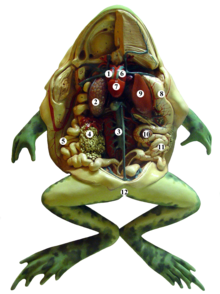Q & A about frogs:
1. What is the significance of frogs (why were they a part of the evolutionary diversity animal dissection kit)? They represent the transition from an aquatic lifestyle to a terrestrial one -- the shift from water life forms to life on land.
2. What is a tetrapod? An animal with four limbs, typically two forelimbs with upper arms, forearms, and hands, as well as two hindlimbs with thighs, lower legs, and feet.
3. Do frogs have nostrils? Yes, we found two nostrils, right where you'd expect them.
4. How do frogs hear? They don't have external ears, but they have tympani, which are disc-like structures used for sound reception, and they have an inner ear.
5. Do frogs have eyelids? Well, they don't have moveable eyelids, but they have a nictitating membrane that moistens and protects the eye.
6. What is the glottis? The glottis is a slit-like opening at the back of the throat that leads to the lungs. It is next to the opening to the esophagus, which leads to the stomach.
7. How many sets of teeth do frogs have? They have two sets of teeth, an outer set of maxillary teeth and also vomerine teeth. We had a hard time finding these teeth, because they don't look like our teeth. They look more like little bumps of cartilage.
8. What are Eustachian tubes? Frogs have them on the sides of the roofs of their mouths, and they lead the ears. Their function is to equalize pressure inside the frog.
9. What internal organs did we look for? We saw the stomach, small intestine, large instestine, liver, gallbladder, and pancreas. We also saw the heart and lungs, and eventually found the kidneys, bladder, and reproductive organs (testes in males and ovaries in females).
10. How many chambers did the hearts have? They had three chambers: two atria and one ventricle.
11. Could we tell the males and females apart? Yes, it was very cool. The females had long squiggly oviducts that ran all the way up the sides of the frogs, which sortof looked like small intestine. I guessed that perhaps they needed really long oviducts because they need to squirt out a huge number of eggs at one time. The males didn't have this, and instead had testes, which looked like small white kidneys and were located right near the kidneys (which were dark red).
12. What do kidneys do? Kidneys filter the blood and put the waste products into the urine to be peed out. We clarified that the reason urine doesn't look like blood is because the hemoglobin bound to oxygen, which gives blood its red color, isn't a waste product, and that waste products are colorless or yellow, for the most part.



funny video Jolien.i liked it a lot.
ReplyDeleteWow Jolien, That was a very cool stop action video that you found on youtube! I used to do stop action videos like that, maybe sometime I should put them on youtube and show everyone.
ReplyDeletehahahahahaha
ReplyDeletethat was strange.
ReplyDeletethat was cool and strange at the same time.
ReplyDelete